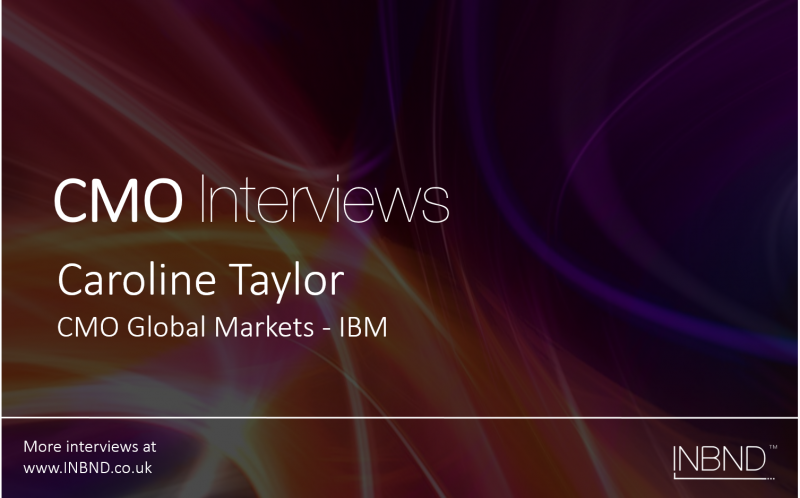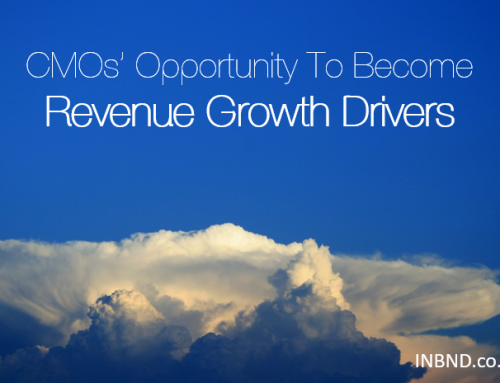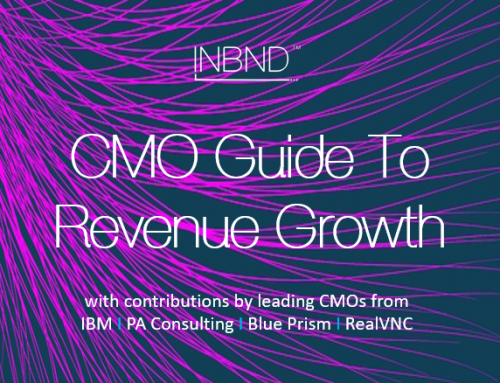The CMO Council and Deloitte found that the role and mandate of CMOs globally are changing towards a more revenue-oriented approach. However, the reality in 2017 is that often this is not reflected in practice. Read this interview with Caroline Taylor, CMO Global Markets at IBM, about her view of what the revenue focus should be for today’s Chief Marketing Officers.
In a new series, INBND interviews CMOs from a variety of backgrounds and companies to dig deeper into CMO opinions, concerns, visions and strategies. Do they reflect the CMO Council’s findings and do CMOs agree with their apparent new mandate of growth?
In this interview with Caroline Taylor, INBND’s Managing Director Lev Cribb finds out more about the IBM Global Markets CMO’s views on marketing, growth and revenue – and where the modern CMO fits into the equation.

Hello Caroline, please tell us a bit about yourself. What is your background and what path took you into the role of CMO?
From a high-level perspective: Marketing since 1983. Tech B2B Marketing since 1992. IBM since 1997. I started at the bottom (most junior of marketing assistants) and worked my way up! I should probably confess to having no marketing qualifications, just 30+ years of hands on experience!
Can you tell us a bit more about your progression within IBM? What were the key moments of taking steps up to (and into) the role of CMO?
The first thing I would say is that IBM has multiple CMOs. Obviously, we have one at the top, but we also have CMOs in each of our 7 geographical units around the world and for each of our business units.
I joined IBM through an acquisition. I had worked for another company called Unison Software and IBM acquired them and merged them into a, then just newly acquired, company called Tivoli in 1997. I went into Tivoli and eventually ran Tivoli’s EMEA marketing after 5 years. I then ran storage marketing in IBM’s hardware business from 2003 to 2005. After that I took over and ran the European Marketing for our business consulting services, what we now call GBS, for a couple of years. Following that I went on to setup and lead the European Marketing for what most business would call SMB.

Then, on the back of that, I got my first CMO role to run Marketing Communications for IBM in the UK and Ireland. That was my first real taste of being a CMO, because you have the complete remit for all aspects of IBM in a particular market. I did that for nearly 5 years, which was an amazing job. You manage everything from advertising to PR, demand generation, the strategy, but obviously working with the rest of the IBM machine. And you have all aspects of IBM’s business, from a comms perspective, report into you. So that includes software, hardware, services and so on.
On the back of that I was promoted and was asked to run marketing for IBM Europe, so I became CMO for IBM Europe at the beginning of 2013. I did that until last year when I was asked to take over and lead marketing communications for our seven geographical units globally, therefore becoming CMO for what IBM calls IBM Global Markets. That includes anything outside of the headquarters itself.
Can you tell me a bit more about your own revenue growth focus – did that come naturally or did you actively develop it over time?
I guess it had always been there to an extent. Before IBM I had worked in pretty small companies. In a large company, like IBM, it’s very easy for people to become disconnected from the end game, because everything is so compartmentalised and you’re responsible for a smaller piece. If you work for a smaller organisation you have a much clearer view of the purpose of the business and that means ultimately, you’re looking for profitable growth.
I have the advantage of having run my own business for 3 years, way back when. I am very fond of telling people it makes you a very good direct marketer, because my goodness you are careful with every stamp and envelope – as direct marketing worked back in those days. So, I’ve had to explain to many people over the years that this is not just about revenue, it’s about profit. Because, if this was your business, the profit would be your salary. I suppose it’s always been quite natural for me to know that that is my mission and to drive profitable growth is what we’re here for. But I also personally subscribe to notion that it’s got to be good and sustainable profit. Doing things that are good, both in the short and the long term. As I work for an American company, we’re measured every quarter, which is not always comfortable. I am very conscious of, and I believe that, marketers have a very specific mission to help organisations to focus their strategy not just on short term, but also medium and long term. Of course, from time to time we do very strategic things with a short-term focus, but if you do that myopically without a view of the longer-term impact, it’s counter-productive and you end up in the wrong place. That doesn’t help anybody. You just grow like mad for a year and then have five years of decline. Someone very wise once said that companies need to produce goods that are good and services that serve. I truly believe that this will sustain you in the longer-term.
That focus on growth and profit has always been there for me and this has always been very clear to me. Not every company measure their employees on it, but we actively do.
In your opinion, who holds the responsibility for revenue growth: Sales, Marketing, or the C-Suite? And why?
All of the above. top and bottom line growth is a shared mission for the C-Suite, and all of them should be measured on it. It has to be, because if you give it to one, then it kills the collaboration required to make it happen. However, Product/Offering Management, Marketing, and Sales have the biggest impact on it, so they should take a bigger responsibility and more accountability. But if you make it just one team, it is likely to result in failure.
The CMO Council’s finding show that senior leadership, including the CEO, look to the CMO to drive growth. Given your answer about it being a shared mission for the C-Suite, how do think it should be shared?
I think there are three primary disciplines, and therefore three leaders who need to take ownership of this. The job titles vary tremendously, depending on the company, but essentially whoever is responsible for product/offering management. In some cases, it’s the CMO, but quite often it’s not. Certainly in the tech world it tends not to be.
But it’s also marketing and sales. What happens often, though, is that too much emphasis is put on the sales and marketing piece, and not enough on the offering and product management piece. And then that gets out of kilter too. There is no point in beating up sales or the marketing execution when you’re not growing, if the product is a dog. You need to have a great product, and then you need to have a great sales and marketing strategy that gets it out to the people who can make use of it and therefore pay for it. If you get any of those three elements out of balance you are going to fail. They need to be accountable to each other to really effectively collaborate. Often product management can’t effectively do their job if marketing doesn’t give them feedback from the clients. Sales and marketing need to be joined at the hip in order to follow through. Each of the three feed the success of the other – if it is working as it should do.
When the CMO Council research findings show that, in practice, the majority of CMOs don’t (or can’t) prioritise a growth mandate, does that surprise you?
This is a really common challenge. The way I see it, it’s about the difficulty to get agreement to deprioritise something in order to replace it with a growth oriented activity that is different and new. Often the conversation goes like this: “We have a new priority of X, but we can’t deprioritise Y”. Yet you often end up doing both with same amount of people and the same amount of money etc. That is a genuine challenge and the only way you can really get the right answer is to look at it holistically.
Within the world of the CMO, within the resources and budget they control, solving this challenge can be nearly impossible. But if it is a shared mission across product management, sales and marketing then you start having a different discussion. You’re suddenly looking at a bigger pool of money, which gives you a better chance to do something different. For me this can’t just be about the CMO’s responsibility and for the CMO to figure out by themselves. It’s got to be a more holistic approach.
As a board member in any company, you don’t expect CMOs to work in little silos of responsibility. You expect them to work as the CEO or the Chairman of the Board does, i.e. to the benefit of the whole organisation, which is easier said than done, of course.
The strategic vision of an organisation should be determined by the CEO, but I would expect that to happen in collaboration with their executive officers and the board. I would expect them to look to the CMO and some of the other C-Suite officers to help develop that vision.
What would be your advice to CMOs who don’t yet actively drive a growth agenda?
You have to insert yourself into the process. Go beyond the “one P of marketing”, i.e. promotion. There are many Marketing Directors, whose remit and compensation is oriented solely around promotion. Often its only about brand and demand gen. You have to insert yourself and bring value, which is way easier now than it was 10 years ago.
Data can now bring a much greater amount of intelligence and insight to the board and the executive leadership. For example, insight on what customers think of you, what they think of the product, what the competitors are doing, how your own investments are performing etc. To me, that’s a real opportunity to bring insight that nobody else has. And that opens up doors that probably weren’t open before.
Data and the insight that derives from it, gives you the key to the door and gives you a right to a seat at different tables. That’s really important. There are some really advanced organisations that have done it for a long time, but really I’ve seen this happen over the last 5-10 years.
Jake Sorofman at Gartner wrote a brilliant piece a few years back called “The rise of the digital CMO”. It made me realise that I was quietly shifting myself form being a very analog CMO to being a digital one, and that many old skills weren’t going to serve me very well anymore. It’s about bringing the insight to bear that’s really valuable in these higher-level decisions. But in order to do that you need to equip yourself with how to make use of it and how to maximise the influence from it. If it’s not something you’re familiar with, you’ll need to spend some time becoming more comfortable with it.
Specialist and commercial terms such as LTV, ACV, various conversion rates etc all have massive implications and you need to understand them. These are not only determined by how brilliant you are at selling your stuff, but also by the nature of how people buy. Certainly in my world this is changing rapidly. We’ve gone from a place where you see an enterprise software licence agreement being sold for 2-3 years change to selling a monthly license for Software as a Service, for example. That is changing our world massively. We have to be proactive in dealing with that reality, because it’s market driven.
So, all of those pieces, including the length of the sales cycle, the average yield, have got something to tell you about your growth trajectory. There’s a really important point here, because there are times in the life of your business when top line growth isn’t the biggest thing. You may face a period of reordering in your business, in order to be sustainable in the long-term. I.e. making sure you continually deliver value to your customers. That’s an interesting one for me – there are times when growing the top line can’t be the primary focus, because the long-term ability to deliver value to your clients is of primary importance.
Obviously, you don’t want to decline either, and certainly you should be looking for ongoing bottom line growth. The way I look at it is that growth is measured in three ways: market share, bottom line, and top line. To me, the real measure of the CMO is the answer to the question “Are you growing your market share?”. I often have these discussions internally, and ultimately it comes to this: if you grew your market share, but it is lower than the overall average market growth, then the result isn’t great. There is nothing especially clever about growing, if the market is growing even faster. So, for me, market share growth is the real measure of the impact we’re having.
In your opinion, what is the best way for CMOs to influence and drive revenue growth?
Data. It’s how we build our investment cases, it’s how we prove the value of every £$€ spent. When we’re data driven in how we plan, how we execute and how we measure success, we establish a credibility that goes way beyond the persuasive arguments of a seasoned marketer.
Can you give me some examples?
First thing is really understanding the market and drawing a lot of insight from a lot of sources of data available in the market. That helps forming your strategy and where you’re going to focus. That’s simple, if you’re a single product start-up, but for larger organisations its more complicated. Your decisions need to be data driven and not based on a whim or on whose voice is loudest. Understanding that is really important. You need to understand the market and your own portfolio. And you need to know what every dollar buys.
We have been putting in place a lot more tools to measure, with great precision, the ROI of all our marketing investment. This way, we can double down on the investments that are yielding well and refine, or stop, any investments that are not yielding well. Having the right tools to allow you to do that is critical.
Get your own data or buy it in the market place, from the usual sources like analysts etc, so you can make your case about where you’re going to invest and how. Really understanding the entire customer journey and every step along the way, including conversions from initial touch point etc, helps to optimise your investment. That approach makes us more successful in our demand generation mission, but it also enables us to make the case to increase investment in certain areas, in order to support the growth strategy.
Data, and the insight you draw from it, has become of paramount importance. No longer are you trying to sell an idea to the CEO, or whoever holds the purse strings for that particular debate, but instead you’re bringing facts and evidence to the table. You’re almost saying it’s coin-operated: If you do this, then that will happen. Of course, it’s not quite as binary as that, and it’s a bit more nuanced, but we’re moving closer to that logic.
What do you think are some of the main challenges for CMOs to drive revenue growth?
The obvious one is you’ve got to get on the data curve, because the insight is there and your competitors are doing it. It’s like this: If you want to go to university, you have to work hard at school. It’s pretty straight forward to understand. The reality of it is that CEOs, your fellow C-suite officers, and the board members all know that this is now possible. It’s nothing new anymore. We’re now past the stage where you can afford not to go there. We now need to be a data-driven CMOs, which is more important than being a Digital CMO. It is critical, and if you don’t then you risk being left behind.
How can CMOs ensure they drive growth AND continue to fulfil the traditional role of the CMO as brand ombudsman and ambassador?
Maybe it’s my long time spent in B2B, but in my world it’s always been about both revenue generation/growth AND brand stewardship/reputation management. These 2 things go hand in hand, and unless you keep them in balance, you will suffer long term. It’s a bit like the ‘good profit vs bad profit’ thought – you can drive growth/revenue to the exclusion of all else, but it’s unlikely to be a successful long term strategy, whereas driving growth/revenue whilst also carefully managing reputation and the brand, you will set yourself up for long term success (delighted customers becoming advocates and making the growth/revenue mission easier).
Given the growth and development of marketing technology, how technical should a CMO be today? Does a non-technical CMO have a disadvantage when it comes to driving revenue for a modern organisation?
For me, it’s all about knowing enough to be able to understand the art of the possible. So CMOs need to understand what marketing technology can deliver/enable, but they don’t need to know how (as long as they have a team populated with those who are deeply expert in the ‘how’). If you understand the potential outcomes, you can challenge your team and suppliers/partners to use technology to drive to those outcomes and beyond. An orchestral conductor doesn’t need to know how to play virtuoso violin to know what sounds a brilliant violinist can produce…
What is the best business advice you have ever been given?
- Never assume (anything)
- Whatever interests my boss, fascinates me
- Some things are just gravity, don’t waste time and energy fighting it
What is your favourite business book, and why?
The Ultimate Question – by Fred Reichheld
NPS is game changing, and under-valued in many B2B companies. It’s an incredibly simple concept, and yet some organisations are still a long way away from applying it.
Thanks for giving us your time and insight, Caroline.
It was my pleasure!
For more information about IBM, go to www.ibm.com, or connect with Caroline Taylor on Linkedin. Enjoyed this interview with Caroline Taylor? Read more CEO and CMO interviews on the INBND Blog.
About INBND Growth Marketing:
INBND provides Growth Marketing Consultancy Services to B2B organisations.
Lev Cribb started INBND to address one big problem: the disconnect between lead generation and sustainable revenue growth. Or in other words, between marketing and sales. He saw too many companies grow inspite of their lead generation efforts, not because of them. INBND brings the passion, expertise and focus to drive change in your organisation. Get in touch today and find out how a modern approach to revenue generation can help accelerate your growth.










